Post by ChrisB on Feb 14, 2019 21:53:39 GMT
NOTE: Back in October 2009 I wrote the following article with the valuable assistance of Barry Hunt (TAS member Barry). It ceased being publicly available in 2014 but I thought it was about time to republish it again at The Audio Standard. Some of the images have changed and I have added some additional information.
A HISTORY OF RADFORD ELECTRONICS
by Chris Bennett and Barry D. Hunt
Arthur H. Radford started Radford Electronics in 1946, immediately displaying an innate understanding of the design and implementation of transformers. The original amplifiers were intended to be used in professional applications such as PA systems but soon afterwards it became clear that the hifi market was one which could be pursued with success.

The first hi-fi product were power amplifiers which boasted incredibly low levels of distortion - so low that the company had to fashion a new means of measuring this parameter. Radford lab gear was later to become just as famous as its audio gear, aided by the fact that the Nuffield Schools Science Programme recommended the use of the Radford model – most schools had Radford ‘Labpacks’ in their science departments.
The MK11 and Series 3 Amplifiers implemented a pentode phase inverter at the suggestion of Dr A. R. Bailey and was detailed in an article in Wireless World.
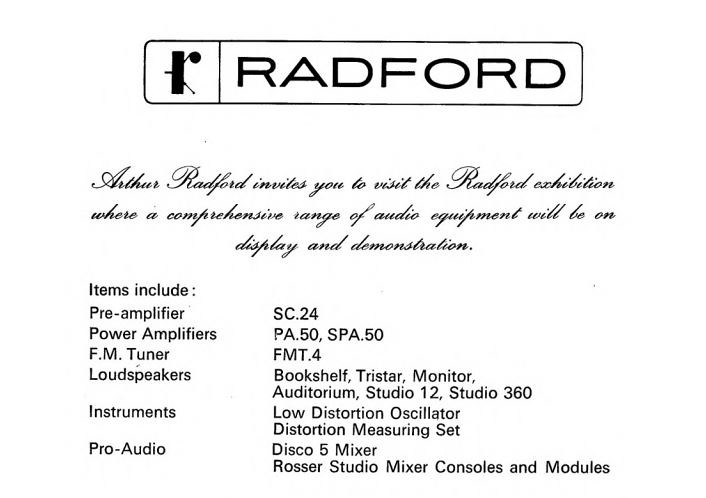
Circuit Diagrams
Basic Amplifier Circuit
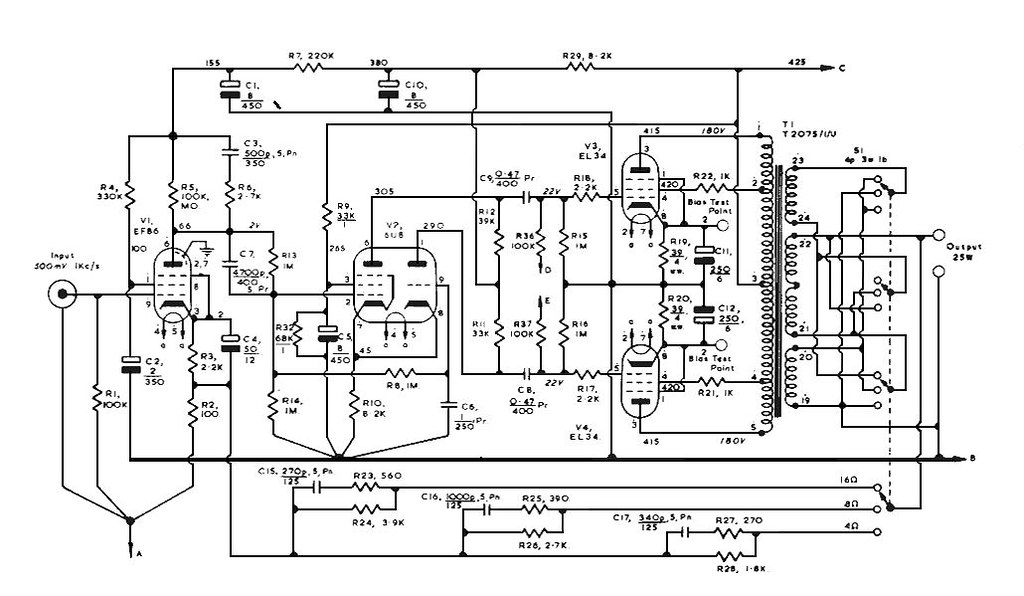
Power Supply Circuit STA25

Power supply Circuit MA25
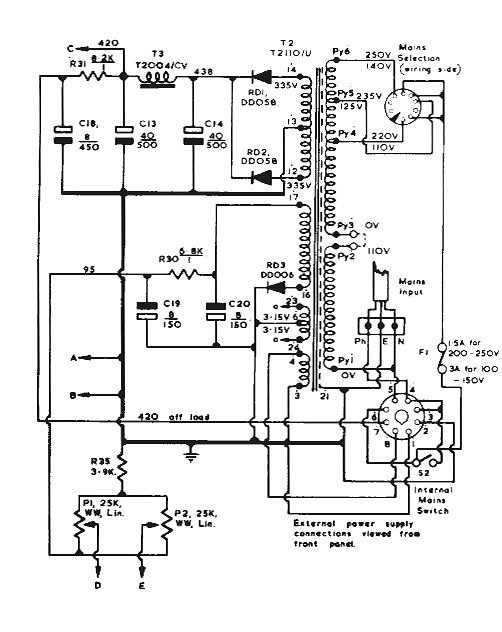
STA15 Power Amplifier
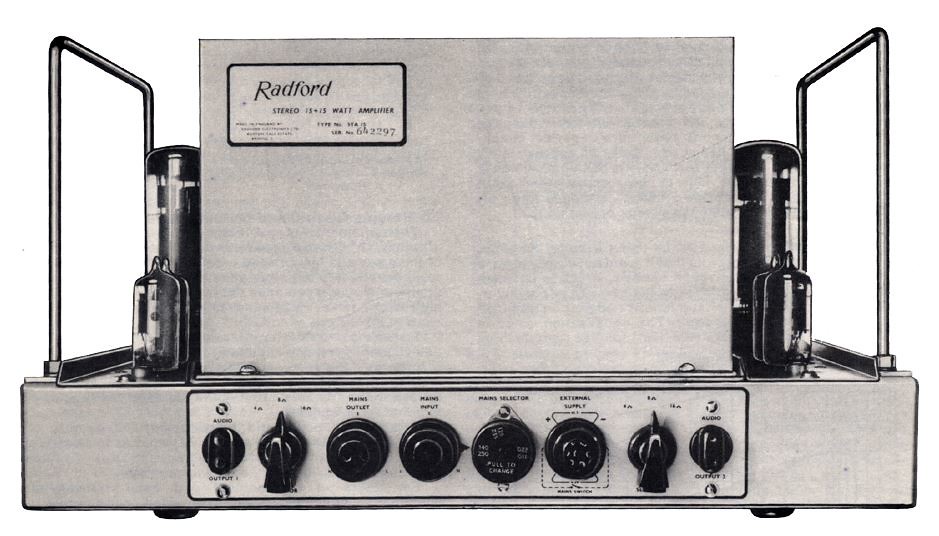
Radford Reference Standard Amplifiers

Later on in the 1960’s the Radford STA25 – a stereo power amp became the piece sought after by the audiophile, selling for a higher price and arguably performing better than the competition from the contemporary models from Quad and Leak.
Arthur Radford also worked with A. R. Bailey to produce the first commercially available transmission line loudspeakers.
Radford ceased trading in 1989 but the lineage continued under the Woodside brand name for several years.
In 2011, a company known as Radford Revival began producing new versions of the STA15 and STA25 models. Using the original handwritten specifications of the transformers, they were able to produce extremely faithful copies of these much loved amplifiers. These are still available direct from Radford Revival (link below).
Old Radford equipment still sells for premium prices and many devotees contend that this equipment can still be favourably compared with some very exotic modern hifi.
Valve Power Amplifiers
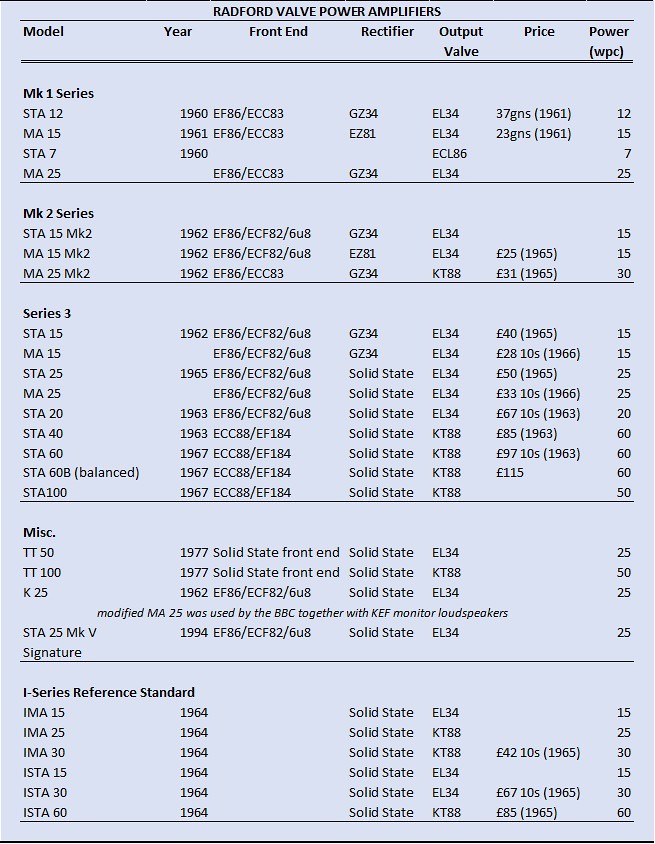

Around the time of the Series 3 amplifiers, there were kit versions of the MA-15, -25, STA-15 and –25 amps designated CMA-15, -25 and CSTA-15, -25. Selling prices were approximately 60% of the price of the factory built units.
Woodside Electronics produced STA-25, STA-35, STA-50, MA-50, MA-75 and MA-100 models.
In 1988 prices were as follows:
STA-25 - £1,115
STA-35 - £1,295
MA-75 - £977
MA-50 (Class A) - £1,063

Radford STA15 Power Amplifier (Photo: Chris Bennett)
Transistor Amplifiers
The SC4-10 was a 15 watt stereo solid state integrated amp, which in 1965 was priced at £72 10s.
In 1968, the SCA30 was released - a 30 wpc integrated at £106
SPA-50 Stereo power amplifier. Output: 50W RMS per channel. HD: 0.02% at rated output. FR: 5Hz - 500KHz -3dB at 50W output. Noise: -90dB. Input: 1V for rated output. Output impedance: 8 Ohms. Mains: 110, 120, 130, 220, 230, 240V AC. Size: 10 3/4 x 4 1/2 x 12 1/2 in. Price: £85. Intended to be partnered with the SC-24 Control Unit (see below)
PA-50 monoblock amp. Same specifications as the SPA-50, but of smaller size: 12 1/2 x 4 1/2 x 8in. Price £55.
The Zero Distortion Range of 1975 (so called as their distortion products were below the noise level) consisted of:
ZD50 stereo power amplifier
ZD100 stereo power amplifier
ZD22 preamplifier
HD250 stereo integrated amplifier
ZD50 Power Amplifier
The following is the text of an advertisment taken out by Radford in HFN in 1969, when the transistor amplifier was gaining in popularity.
About Power Amplifiers – Valve or Transistor?
If you are about to purchase a high quality amplifier, the question – Valve or Transistor type? – is bound to arise. There are too many parameters to equate and too much conflicting hearsay to make the answer clear cut.
However difficult the purchasing problems may appear to the discriminating buyer, the problem facing the manufacturer of valve amplifiers, jealous of his reputation in respect of performance and reliability, is even greater.
Let’s face it. Generally speaking transistor power amplifiers have not turned out to be quite what we were led to believe. We have found all manner of faults and snags in practice which were not envisaged. Omitting such objectionable characteristics as blowing up when the output is short circuited, what is basically wrong? In the main, transistor amplifiers sound different from valve amplifiers, and produce listening fatigue. This we believe to be due to some design inaccuracies, but fundamentally to the use of the high power-efficiency class ‘B’quasi-complimentary circuit.
This circuit inevitably produces a large amount of distortion by class ‘A-B’ valve standards. The reasons for this will be given in an article to be published later. Simple harmonic slope distortion can be reduced by negative feedback but the effects of crossover distortion cannot. Have you noticed that in most transistor amplifiers the measured harmonic distortion does not decrease linearly with output? The most significant observation is, however, that the amplifiers sound far worse than measurements indicate when compared with valve amplifiers.
Good transistor amplifiers can be made, of course, but the disparity in price to performance ratio when compared with valve amplifiers has been too great to ignore except for professional users.
How does the best transistor amplifier compare with the best valve amplifier? It is not remarkable that one cannot detect the slightest difference in ‘A-B’ testing, or in the fatigue factor, on the finest reproducers available, on any kind of programme material. In our long but interesting research into transistor amplifier design it has been our endeavour to build an amplifier that sounds the same as a ‘Series 3’ valve amplifier.
What is the message? It is, that if you have purchased, or are about to purchase, a good valve amplifier, it will not become obsolescent in respect of performance. If you purchase a transistor amplifier it will be for other reasons.
If you are about to purchase a high quality amplifier, the question – Valve or Transistor type? – is bound to arise. There are too many parameters to equate and too much conflicting hearsay to make the answer clear cut.
However difficult the purchasing problems may appear to the discriminating buyer, the problem facing the manufacturer of valve amplifiers, jealous of his reputation in respect of performance and reliability, is even greater.
Let’s face it. Generally speaking transistor power amplifiers have not turned out to be quite what we were led to believe. We have found all manner of faults and snags in practice which were not envisaged. Omitting such objectionable characteristics as blowing up when the output is short circuited, what is basically wrong? In the main, transistor amplifiers sound different from valve amplifiers, and produce listening fatigue. This we believe to be due to some design inaccuracies, but fundamentally to the use of the high power-efficiency class ‘B’quasi-complimentary circuit.
This circuit inevitably produces a large amount of distortion by class ‘A-B’ valve standards. The reasons for this will be given in an article to be published later. Simple harmonic slope distortion can be reduced by negative feedback but the effects of crossover distortion cannot. Have you noticed that in most transistor amplifiers the measured harmonic distortion does not decrease linearly with output? The most significant observation is, however, that the amplifiers sound far worse than measurements indicate when compared with valve amplifiers.
Good transistor amplifiers can be made, of course, but the disparity in price to performance ratio when compared with valve amplifiers has been too great to ignore except for professional users.
How does the best transistor amplifier compare with the best valve amplifier? It is not remarkable that one cannot detect the slightest difference in ‘A-B’ testing, or in the fatigue factor, on the finest reproducers available, on any kind of programme material. In our long but interesting research into transistor amplifier design it has been our endeavour to build an amplifier that sounds the same as a ‘Series 3’ valve amplifier.
What is the message? It is, that if you have purchased, or are about to purchase, a good valve amplifier, it will not become obsolescent in respect of performance. If you purchase a transistor amplifier it will be for other reasons.
Radford Preamplifiers
DSM (1961), quite rarely seen nowadays, but in its day offered a comprehensive range of tone control and filters. 3 x EF86 and 1 x ECC83 per channel. (33 guineas in 1961)
SC2, using passive tone controls (£27 10s in 1965)
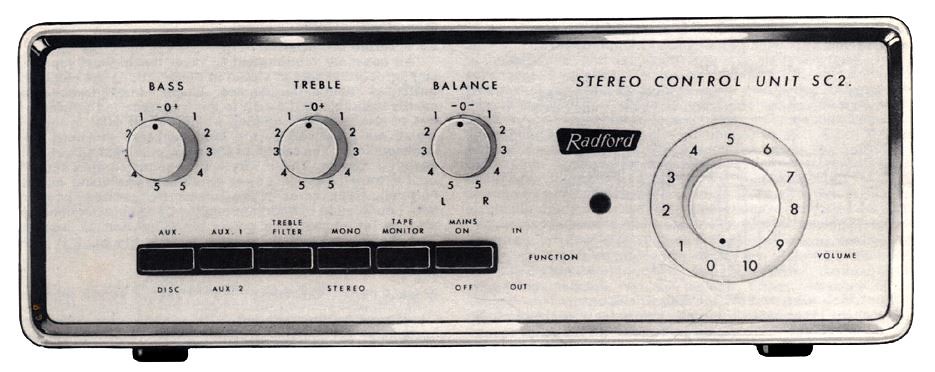
SC3 was a three-channel version of the SC2. The third, or centre channel, was obtained by combining the left and right channels, suitably attenuated. Provided a third centre channel for the American market of that time which favoured three-channel systems.
SC22 used feedback tone controls and a solid-state disc input (£32 10s in 1965)
SC22P as the SC22 but with an integral power supply, making the preamp a stand-alone item. Prior to the SC22P, all the Radford preamps took their LT and HT supplies from the power amp via a multi-way ‘umbilical’ cable, typical of the time and used by Quad and Leak. (£37 10s in 1965)
SC-24 Stereo control unit. Transistors. Inputs: PU 2mV 50K, aux 1 2mV 50K, aux 2 80mV 100K, radio 80mV 100K, tape monitor 80mV 100K. Noise: (2mV inputs) -70dB; (80mV inputs) -75dB. Output: 1V RMS. Controls: balance, bass, middle, treble, selector, filter 4, 7 and 10KHz at 12dB/octave. Designed for use with Radford SPA-50 but suitable for any power amplifier. AC mains. Size: 4 1/2 x 16 1/2 x 9 3/4 in. Price £80.
Radford Tuners
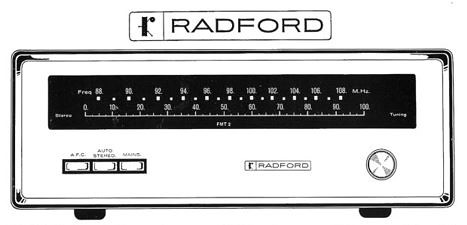
Radford also produced a series of tuners: the FMT1 through to the FMT-4.
FMT-1 was a £30 valve design with several variants:
FMT.M – Stereo version (an extra £12)
FMT.Q – Mono with inter-station noise suppression (a £4 premium)
FMT.Q.M – Stereo with inter-station noise suppression (a £16 premium)
FMT2 was mono (£41 8s), available in 1967 and was accompanied by:
FMT2.MPX. - A model with a stereo decoder (£56 4s)
STX.1 - A separate stereo decoder (£15 15s)
FMT-3 solid state tuner. (£75.40 in 1971)
Radford Loudspeakers
After years of work on the back loading of loudspeakers, Radford & Dr A R Bailey took out a landmark patent for the first transmission line loudspeaker. It had earlier been the subject of an article in Wireless World (Oct. 1965) - 'A Non-resonant Loudspeaker Enclosure'
The first commercial incarnations of the design described in the Radford/Bailey papers were a range consisting of:
Bookshelf - A loudspeaker of the smallest practical dimensions to ensure effective low frequency radiation. Intended for shelf mounting & uses two drive units. The type BD 25/2 bass driver has been specially formulated withy a lighter moving system than the BD25/1 to extend the useful range to 2KHz at the expense of very low frequencies. The TD3/1 treble driver operates over the range 2KHz-25KHz. The static response characteristic has been corrected in the frequency range 750Hz-3KHz to a flat dynamic response thus alleviating the transient distortion colouration inevitable in a two unit system.
It is an inexpensive system with wide frequency range, low colouration and good power handling capacity.
Frequency range 55Hz-25KHz. Power handling capacity 30 watts. Size 21 x 12 x9 in. (53 x 32 x 23 cm) Weight 30 lbs (13 ½ kg)
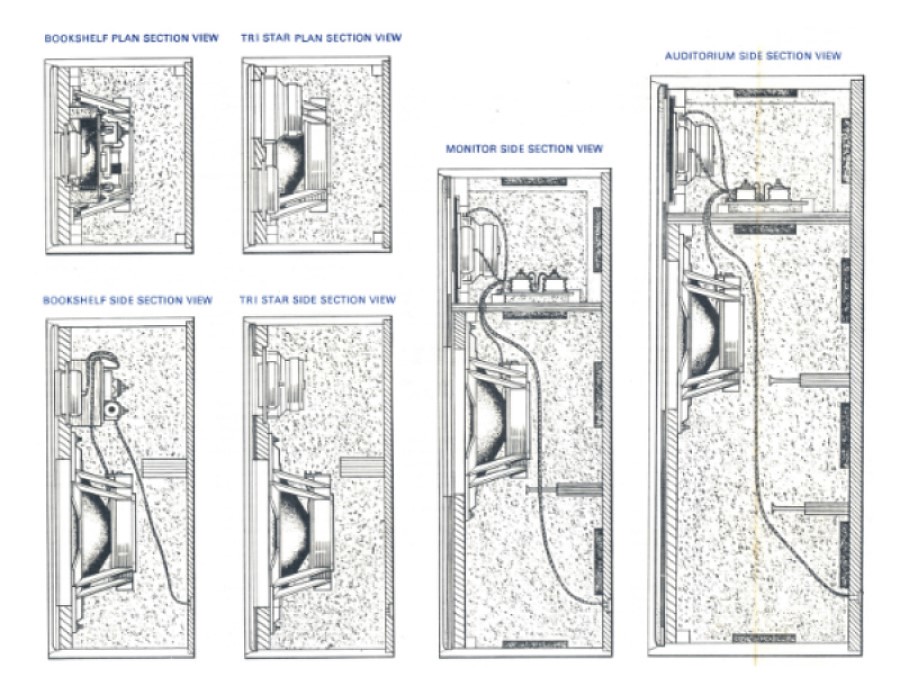
Tri-Star 50 - Identical in size with the Bookshelf loudspeaker but uses three drive units: bass driver BD25/1, mid-range driver MD9/2, and treble driver TD3/1. The mid-range unit is a closed back type enabling it to operate in the same enclosure as the bass driver and operates over the range 500Hz-5KHz.
This loudspeaker is intended to satisfy the requirement for a true high fidelity performance with very low colouration in a relatively small dimension.
Frequency range 55Hz-25KHz. Power handling capacity 50 watts. Size 21 x 12 x9 in. (53 x 32 x 23 cm) Weight 33 lbs (15 kg)
Monitor - Intended for floor mounting, preferably on a suitable stand. Uses three drivers: BD25/1, MD9/1, & TD3/1. The mid-range driver is of the open back type which operates in a separate enclosure from the bass driver. The type MD9/1 unit has been developed from information obtained from an intensive study over the last three years into transient distortion colouration.
This is a full range loudspeaker remarkably free from colouration with small free standing dimensions.
Frequency range 55Hz-25KHz. Power handling capacity 50 watts. Size 30 x 12 x 10 1/2 in. (76 x 30.5 x 25.5 cm) Weight 43 lbs (19.5 kg)
Auditorium - A floor mounting loudspeaker (preferably on a suitable stand) using the same units & networks as the MONITOR but having larger enclosures for both bass & mid-range units.
For medium and large rooms with enough space this loudspeaker will provide a substantial low frequency response in addition to smooth and relaxed mid & high frequencies, free of colouration.
Frequency range 40Hz-25KHz. Power handling capacity 50 watts. Size 36 x 16 x 13 in. (91 x 40.5 x 33 cm) Weight 70 lbs (32 kg)
Studio – A floor-mounting loudspeaker of suitable height without a stand for optimum listening satisfaction. Uses same units as the MONITOR and AUDITORIUM loudspeakers. Bass driver is rear-loaded with an open end acoustic transmission line which extends the flat response down to 30Hz. Due to in-phase radiation below 50Hz from spaced sources the wavefront tends to plane configuration giving a higher subjective sensation than a virtual point source velocity wave (due to the diaphragm only) at these frequencies.
A loudspeaker with the highest possible performance for medium to large rooms. Provides a clean response over the whole audio frequency band from below to above audibility.
Frequency range: 30 Hz - 25kHz. Power handling capacity: 50 watts. Size: 45.5" x 17" x 15" (115 x 43 x 38 cm). Weight: 98 lbs (44.5 kg)
All models were available in afromosia or semi-matt hard epoxy white painted.
They were revised as Mk II models by 1971
The Studio design became two separate models:
Studio 12 – An Auditorium but with an acoustic line terminated enclosure on a 12” bass driver. Power handling 50 watts, impedance 8-16 ohms. Size 45.25” x 17” x 15” Price £100
Studio 15 – As for the Studio 12 but with a 15” bass driver. 49” x 20” x 17” Price £125
The late ‘70’s saw the Studio range of speakers where multi-directional and the model numbers indicated the degrees of sound radiation.
Studio 360 – used 10 drivers per channel in a 360 degree array.
Studio 270 – used 7 drivers
Studio 180 – used 5 drivers
Phono Cartridge
1963 saw the introduction of the Radford Moving Iron pickup cartridge – price £5 plus purchase tax. It was made for Radford by Bang and Olufsen. It was described as using four exciting coils in push-pull pairs, having a high compliance and low tip mass
A universal headshell was an option it was manufactured by SME and badged as Radford.

Transformers
Arthur Radford’s transformers were of exceptional quality and a range of specifications were available for the home constructor to build their own equipment with.
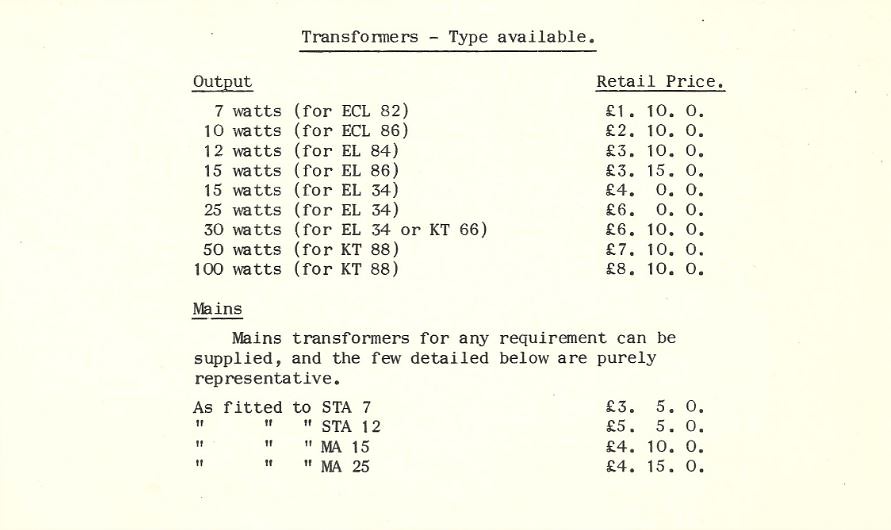
Test Equipment
Labpack – The Radford Universal Labpack Assembly was described as a general purpose instrument with complementary accessories, designed for instruction, demonstration, and experimental use in science laboratories. The pack was comprised of four units:
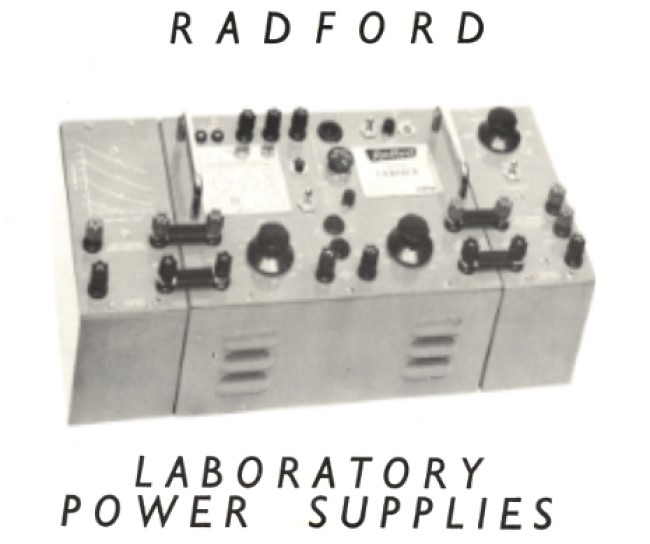
Main Unit ML – a power supply unit
Accessory ALT – Low Tension Smoothing Unit
Accessory AHTR – High Tension Smoothing Unit, Regulated
Accessory AHTH – High Tension Smmothing Unit, Heavy Duty

The system was designed to cover almost any requirement for low and medium voltage that might be likely to be met in basic electrical and electronic experiments. The original specification was compiled by D.A. Rock, a school physics teacher, in conjunction with Radford’s development department in order to meet the needs of science teaching. It was then further developed in conjunction with Education Authorities, training establishments and individual science teachers. The design made way for small groups of students to work together on their own benches in order to conduct their own experiments, rather than the whole class gathering around a single large wall mounted unit operated by the teacher, which proved to be a revolutionary method of teaching.
Audio Testing Equipment
A range of five oscillators
Three distortion monitoring systems
Two Voltmeter and Noisemeter systems
The Radford Defroster
A surprising product for a hifi manufacturer, this was a device designed in 1947 for the rapid defreezing of water pipes up to 1” in diameter. It comprised a transformer, heavy duty cables with large crocodile clips similar to those used on car battery chargers and a prod. This was constructed into a steel case with carrying handles. It was mains powered and could be run from wall or lighting socket.
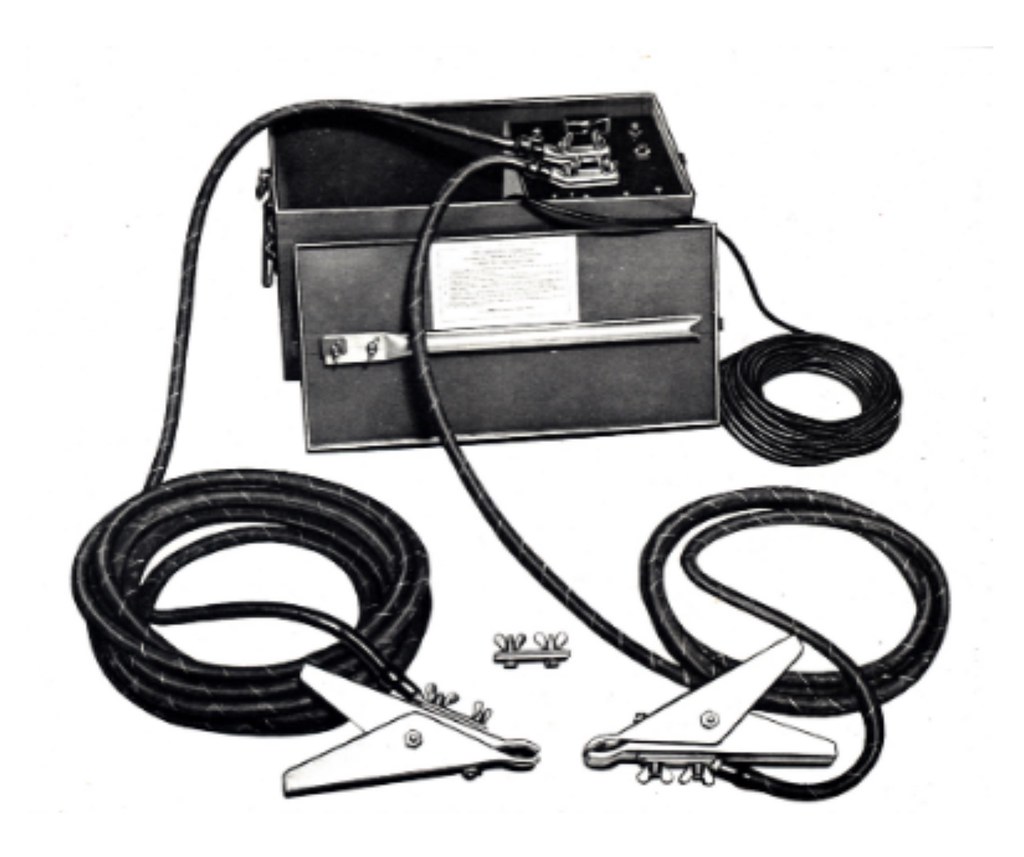
Links
Radford Yahoo Groups
This group is for discussion for all those interested in the products manufactured by the late Arthur Radford and Woodside Electronics. Whilst specifically aimed at the "classic" period of the MA, STA, IMA and ISTA series amplifiers any Radford or Woodside user is welcome.
Whether you own a classic STA 25, ZD-100, Woodside STA or integrated, Monitor loudspeakers or Radford test equipment, please share your experiences, restoration projects and thoughts. Registration is necessary.
groups.yahoo.com/neo/groups/radford/info
Radford Revisited
www.audiomisc.co.uk/HFN/Radford/revisited.html
Stereophile Review
Woodside MA50 Renaissance monoblock power amplifier
By Larry Greenhill June, 1994
www.stereophile.com/tubepoweramps/694wood/
Poppypete’s Place
www.poppypete.f2s.com/
An incredible story of rebuilding a badly built Radford kit amp – including some authentic casework from scratch
Radford Revival
Reissued STA 15 and STA 25 amplifiers
www.radfordrevival.co.uk/





